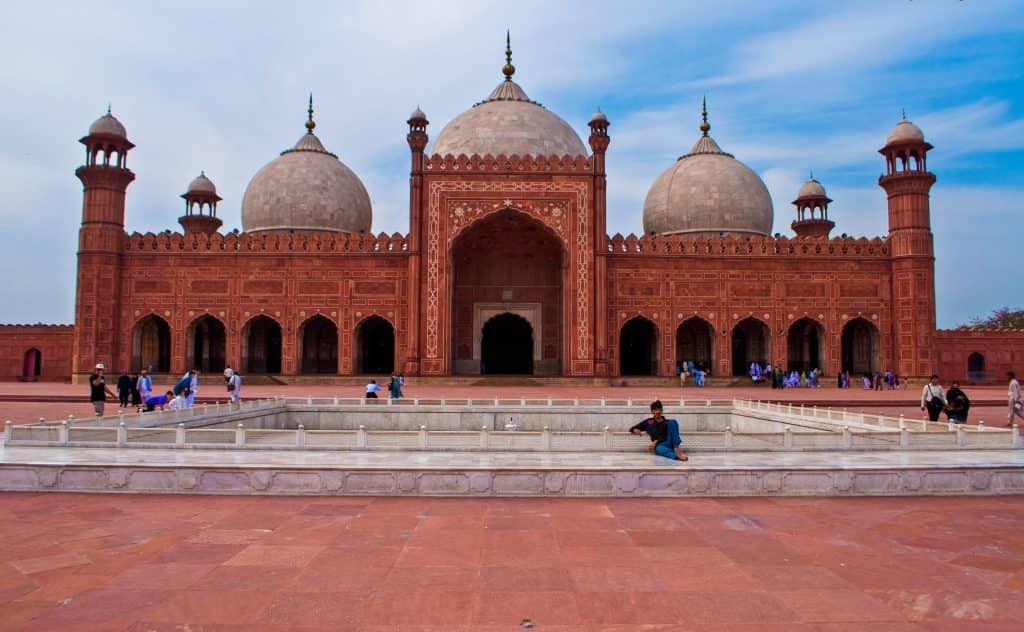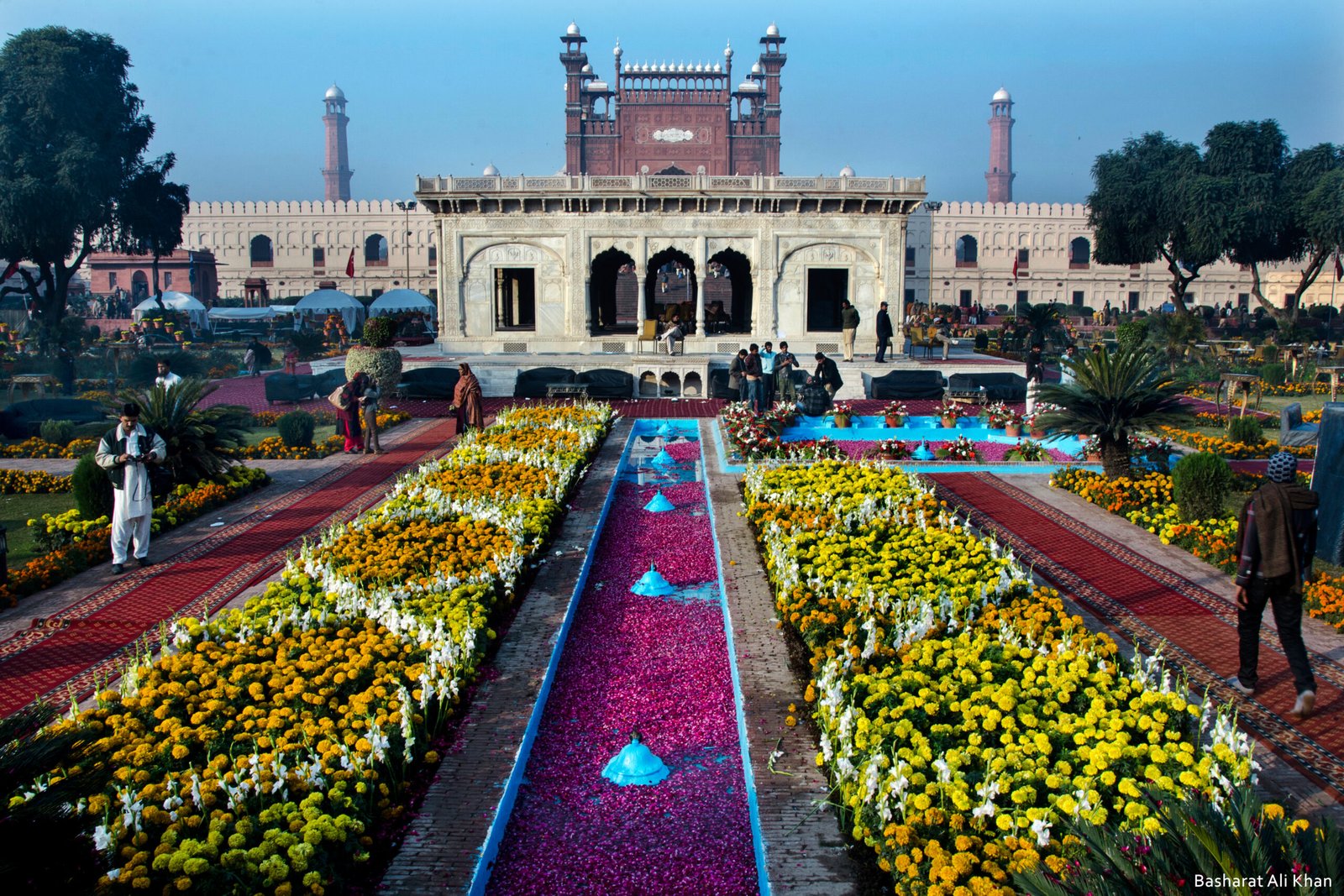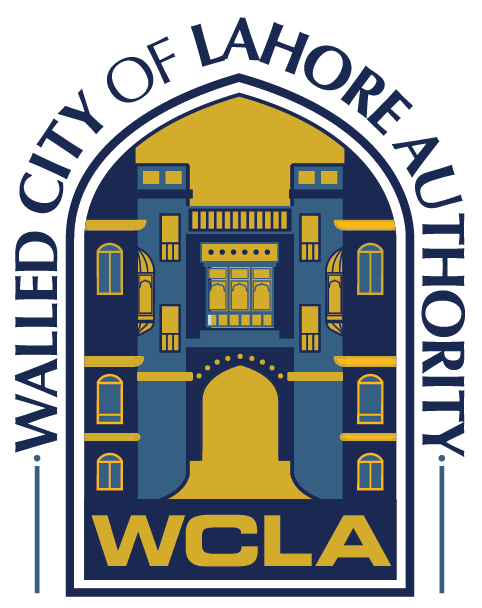
Monuments
Monuments of Walled City Lahore
No one knows how old Lahore is. But according to a Hindu historian Sujan Rai the Lahore derives its name from Loh or Lava, the son of legendary Raja Ram Chandra. The consensus among the historian is that Lahore certainly pre-dates by several centuries the conquest of the region by Mehmud of Ghazna in the early years of the 11th century, but it is not certain by how long. It’s said that there was once a mud wall around the city to save the city from invaders. Which in the later period replaced in baked-brick wall by Akbar who fortified the whole inhabited city with a nine meter high brick wall pierced by thirteen gates. These gates still bear their original names but only one has its original structure named Roshnai Gate.
Mosques Of Lahore

1634-35 AD
Masjid Wazir Khan
The Wazir Khan Mosque sat astride the historic route that the Mughal nobility would traverse as they entered the city and made way to the royal residence in the Lahore Fort. The Mosque comprises a prayer chamber and a large courtyard. The latter is surrounded on its northern, southern and eastern sides with 28 hujras and two Pavilions facing each other across the width of the courtyard. There are four Minars marking the four corners of the courtyard. An important feature of the entrance system of the Mosque is the Calligraphers bazaar that crosses the axis of entrance at a right angle. The Mosque complex, in the form that it has survived, still has a singular outstanding attribute that places it in the frontline of the major monuments of the world- the exuberant architectural decorations that embellish its exterior and interior surfaces. In essence these are of two kinds- exterior surface decorations which are chiefly in the form of glazed ceramic tile murals; and interior decorations in the form of naqqashi wall painting- a semi –dry form of fresco.

1753
Sunehri ('Golden') Mosque, Kashmiri Bazaar, Lahore
The mosque was built in 1753 by Nawab Syed Bhikari Khan (son of Raushan ud Daula Rustam-i-Jung), Deputy Governor of Lahore during the reign of the Mughal Emperor Muhammad Shah. It is called Sunehri Mosque due to the gilded domes and small domlets. Due to concerns by local officials regarding potential traffic problems and the existence of sikh Baoli nearby create hindrance in the construction of the new mosque. Nawab Bikhari Khan had to obtain a fatwa from the Muslim clergy to subdue the religious resistance. He overcame the secular opposition by constructing the Mosque on an eleven-feet-high plinth that allowed for many shops on the ground level under the mosque, on all its sides, leaving only a small portion for the staircase. The rent from the shops was to pay for the upkeep of the Mosque. The shops still exist today. From 1767, the triumvirate of Lehna Singh Majithia, Gujjar Singh Banghi and Suba Singh ruled Lahore for thirty long years until the amalgamation of Punjab into a single empire by Ranjit Singh in 1799. They converted the Sunehri Mosque to a Gurdawara and placed a copy of the Sikh holy book Granth Sahib in the prayer hall. The stated pretext for this imposition was that the call to prayers disturbed the Sikh ceremonies in the adjacent Baoli garden. During the Ranjit Singh’s rule in 1820, Fakir Azizuddin foreign minister and trusted lieutenant convinced the Maharaja to restore the place to the Muslims. Ranjit agreed on the condition that the volume of Azan – call for prayers – be kept low and the shops rentals would be forfeited. The Granth Sahib was consequently removed, Gurdawara was converted to a Mosque and the Muslims resumed their prayers.

1673
The Badshahi Masjid
The mosque was built under the patronage of the sixth Mughal Emperor, Aurangzeb Alamgir. It was completed in 1673 under the supervision of Aurangzeb’s foster brother Muzaffar Hussain (also known as Fidaie Khan Koka) who was appointed governor of Lahore in May 1671 and held this post until 1675. He was also Master of Ordnance to the emperor. The construction of the mosque took about two years, from May 1671 to April 1673. The mosque was built opposite the Lahore Fort, illustrating its stature in the Mughal Empire. In conjunction with the building of the mosque, a new gate was built at the fort, named Alamgiri Gate after the Emperor. During the Sikhs rule, they used the mosque as a horse stable and Muslims were forbid to enter in Mosque. While British’s also used the mosque for military training including rifle and cannon fire range and later on they handed over the control of Mosque to the Muslims as a gesture of good will. A Committee was formed to restore the Holy place to its original glory. The Committee carried out extensive repair works from 1939 to 1960. Those repairs brought the mosque back to its original shape and condition. Capable of accommodating up to 60,000 worshippers, it is the second largest mosque in Pakistan. Like the character of its founder, the mosque is bold, vast and majestic in its expression. The interior has rich embellishment in stucco tracery (Manbatkari) and paneling with a fresco touch, all in bold relief, as well as marble inlay. A small museum was also b added to the mosque complex some 40 years before, which contains relics of Muhammad SAW, his cousin, and his daughter, Hazrat Fatima Zahra. Walled City of Lahore Authority is doing conservational works inside Badshahi Mosque and also shifting the Holy Relics Chamber to the ground floor of Mosque.

1614 A.D
The Mariam Zamani Masjid
This is one of the most ancient mosques in the city. It is situated close to the Masti Gate of the city, opposite the eastern walls of the fort. It was built in 1023 A.H. (1614 A.D) during the reign of Jahangir, by his mother, Mariam Zamani. According to the Ain-i-Akbari , she was the daughter of Raja Behari Mal and sister of Raja Bhagwan das. The style of the building is transitional between the Pathan and the Moghal. Its massive domes, one large and two side ones, and bulky arches, are in the old pathan style but the gate ways, the balconies and the side- rooms are more moghal in their construction then pathan. The mosque is surmounted with four arched towers, one at each corner. It is built of bricks, cemented by chuna of the best quality, so excellent, indeed, that the strength of the building seems to depend entirely on its adhesive properties. In the center of the courtyard of the mosque is a fountain of water for the ablution of the faithful. The masjid was used by Ranjit Singh as a gun and powder manufactory, and on that account came to be called the barut –Khana wali masjid. The establishment was under the superintendence of jawahar Mal Mistri. The mosque was restored to the mohamadans by Major Mcgregor, Dupty Commissioner of Lahore, in 1850, together with the shops and the houses attached to it.

1606
Masjid Kharasian
Inside the Lohari Gate, near chowk Bukhari, a little northward from the chowk is a small mosque, today called Masjid Kharasian, its original name was Masjid e Sadar Jahan. It was built in 1606, the second year of Jahangir’s reign. It is much repaired and renovated, but the original Katba, bearing a Persian inscription in red stone by the calligrapher Abdullah Al-hussaini, still adorns the staircase that lead to the mosque proper on the first floor.

1460
Neeven masjid
Niween masjid is situated in chouk Matti, between the gates of lohari and shah alam gate. This mosque was constructed in 1460 and it is said that it was constructed by a minister of Ibrahim Lodhi named Ameer Zoilfiqar khan. This mosque is one of the oldest mosques of the middle east. The speciality of this mosque is that it was constructed one floor beneath the ground level. The sewerage system of this mosque is considerd amazing as common people feel strange that how the water from this mosque is disposed off owing to such lower level. There are two wells under the mosque that absorb all the sewage water of mosque.
Other Monuments

Shahi Hamam
Commonly known as Shahi Hamam, the Wazir Khan Hamam was built by Sheikh Ilmuddin Ansari in 1634. The Hamam is the only surviving public bath from the Mughal era in Pakistan. The single-storey structure is spread over 1,110 square feet and was built using brick tiles and limestone cement. The building is a combination of Turkish and Persian style. It reminds one of the traditional Persian hamams which are still vogue in Iran. It is a single storey building with beautiful paintings and has three types of bathing facilities such as cold, hot and steam bath. All these facilities have been divided into separate sections. Massage and other similar facilities were also provided. In 2012 the Walled City of Lahore Authority, understanding the importance of Shahi Hammam, removed 52 encroachments from its façade and set out the conservation plan. This Conservation process was completed in 2016 and the same year Shahi Hammam won the Award of Merit by UNESCO for best conservation practices in Pakistan. During the conservation, the white wash over fresco work was removed through certain chemicals for revealing the original fresco underneath. Fresco experts from Sri Lanka who toiled with the students of National College of Arts carried out this task. Marble floors were laid in all the 21 rooms of the Hammam in 1991 restoration by the Archeology department. These floors were excavated during the 2014 conservation to reveal the hypocaust system.

The Baoli sahib
Behind the Golden Mosque Bhikari Khan is a baoli or large well, with steps descending to the edge of the water. The well was dug by Arjan, the fifth sikh Guru, in the time of Jahangir and had a large alms house attached to it. In the time of his successor, Guru Har Gobind, owing to a quarrel between the Guru and the Qazi of Lahore, the Baoli, with all the buildings attached to it was confiscated to the state, and in the place of Langar khana a mosque was built in 1890. The Maharaja, having fallen dangerously ill, was advised by his astrologers to reopen the Baoli and Bathe with its water, which would cure him. He acted accordingly, and is said to have been cured by the bath. He lost no time in demolishing the mosque, and constructed buildings consisting of rooms, chambers and balconies. The place is highly respected by the Hindus, who hold all their important meetings there. The Granth or holy book, wrapped up in a valuable cloth, is placed on a raised platform, and the great kettle-drum is beaten every morning and evening to awaken the faithful to a sense of their duty to the creator. After the death of Ranjeet Singh and to the current period there are no traces in history that what happened to the Baoli and how it reached to this condition of barren garden having no Baoli. Presently the entrance of the Baoli is encroached by shopkeepers and nobody could apprehend what happened to the huge structure which once standing there.

The Hazuri Bagh
The quadrangle now occupied by the garden called Hazuri Bagh with a marble Baradari (1818 AD) in its centre, was originally a serai built by Aurangzeb, where during the Mughal rule thronged the imperial cavalcades and armed retainers. The two storeyed building adjoining the southern gateway (Hazuri Bagh gate) was also originall built in the time of Aurangzeb as a boarding house for scholars. Later on it was used as Abdar- khana or place for keeping refreshing drinks. During the reign of Ranjit Singh it came to be called as Gulabkhana or ‘’Rose-water House’’ , literally rose –house. During the British period it was again used as a boarding house for students. The Hazuri Bagh garden was reconstructed in 1818 by Maharajah Ranjit Singh to commemorate the capture of the Koh-i-Noor diamond from Shah Shujah of Afghanistan. The major monument in the garden is the baradari at its center. It is primarily constructed of marble stripped from numerous Mughal monuments in Lahore, many of which remain standing despite the removal of their marble cladding. Ranjit Singh used the pavilion as a place to hold court, and the mirrored ceiling in the central chamber is a testament to this function.

Chitta Gate
It is situated closely to the Wazir Khan Mosque on the Eastern side. It appears that it was the entrance of the outer premises of the Wazir Khan Mosque. Since it is part of the Mosque planning, its date of construction is the same as that of the Mosque i.e. 1631 AD. The gate is about 16feet wide and 30 feet high in shape of an arch. It is not in a good state of preservation while additionally heavily encroached upon by vendors. The monument is also in the possession and under the control of the Walled City of Lahore Authority of the Govt. of Punjab.

Lahore Fort
This is probably the most charming and grand forts in entire Pakistan. Covering an area of 20 hectares, the size and structure that the fort has, was constructed by Emperor Akbar between 1556 and 1605. The succeeding emperors have all contributed to the styling of the fort; thus you can see different architectural ideas incorporated in Lahore Fort. Also known as 'Shahi Quila' among locales, the main attraction inside the fort are Sheesh Mahal, Alamgiri Gate, Naulakha pavillion and Moti Masjid. The fort was declared a World Heritage Site by UNESCO in the year 1981. The fort has some really wonderful and well maintained gardens all around the fort which further add to the beauty of the fort.

Ranjit Singh Samadhi
Maharaja Ranjit Singh (1780 – 1839) became the first ruler of the Sikh Empire, which came to power in the Indian subcontinent in the early half of the 19th century. The empire, based in the Punjab region, existed from 1799 to 1849.Sikh ruler Maharaja Ranjit Singh’s mausoleum is located in Lahore near the Lahore Fort and Badshahi Mosque. The mausoleum was begun by his son Kharak Singh on the spot where he was cremated. It was completed by Duleep Singh in 1848A.D. The tomb exemplifies Sikh architecture, it has gilded fluted domes and cupolas and an ornate balustrade round the top. Ranjit Singh’s ashes are contained in a marble urn in the shape of a lotus, sheltered under a marble pavilion inlaid with pietra-dura, in the center of the tomb. Ranjit Singh though illiterate, showed great intellectual curiosity so was uncontested master of the region through four decades of the 19th century.

Dina Nath well
Raja Dina Nath was the person, who rose to remarkable power in the later days of Ranjit singh. In 1834 raja Dina Nath was made finance Minister. After annexation of Lahore by the British in 1849, Raja Dina Nath was appointed to the council of Regency. During his time the Raja constructed buildings and gardens for public welfare. Among these was the well he built opposite the white dome in the front of Masjid Wazir khan. The well was set under a dome and open arches provided for drinking of water by the people. It was done by the Raja in 1851 AD at the suggestion of the Deputy Commissioner of Lahore. The Well though still existent and antiquity, is no more in functioning order. An inscription on a marble stone affixed to the southern wall of the structure.. “This well was built by Raja Dina Nath, Raja of Kalanour, at his own expense, at the suggestion of the Major George Macgregor, Dupty Commissioner of Lahore, in 1908 Samvat, corresponding to 1851 A.D

Fakir Khana Meuseum
The museum itself is in a small house in the inner city. The Fakirs were an important family during the Sikh rule of Punjab in the 1700s. Fakir was an ascetic and his sons took over in his role as an important member and minister in the court of the Sikh ruler Ranjit Singh. This small museum showcases the history of Lahore and contains important pieces such as relics from the Prophet Muhammad’s (P.B.U.H) time as well as swords, jewels and coins dating back to the Sikh era and the Mughal rule of the city. Collections within the Museum have been passed through generations within the Fakir Family and number approx 30,000 items from British, Sikh and Mughal eras. The Museum has survived several wars and the India-Pakistan partition. Held within the Fakir Family were several prominent mansions (Havelis) in and around Lahore e.g. Mubarak Haveli and others. The art from those mansions and personal pieces collected by several prominent members of the Fakir Family have also been incorporated into the Fakir Khana collection. Historically the Family was known to possess a large collection of jewels and jewelled artifacts-many of which were personal gifts to the Fakir Brothers by Maharajah Ranjit Singh.
in our city
region covers
garden land
Ownership
Latest Publication
The news about recent activities for needed peoples.



